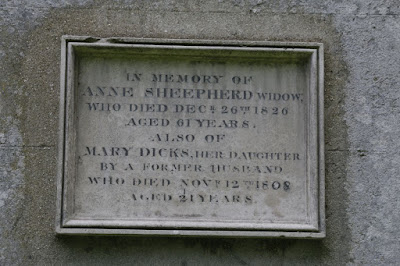I have been meaning to visit this church for quite a while since I missed it when I visited the other churches in the area a while ago. The church is 14th century and looking around you casn see it does date back to that time. Some history from Wickipedia
"The earliest parts of the Church of England parish church of Saint Bartholomew are 13th century, including a stair turret and a number of lancet windows, notably in the chancel. Early in the 14th century the nave was rebuilt in the Decorated Gothic style, with north and south aisles linked to it by arcades of four bays. The west tower and the Perpendicular Gothic east window of the chancel were added in the 15th century. The pulpit and tester are Jacobean and therefore 17th century. The building was restored in 1895 and is a Grade I listed.
Church monuments in St Bartholomew's include a number of brasses. In the north aisle is a brass commemorating John the Smith, who died in 1371.It bears an epitaph written in Middle English, which may be the earliest example of an inscription in the English language.The epitaph reflects upon human mortality:
man com & se how schal alle ded li: wen yolk comes bad & bareIn the chancel are two brasses commemorating John Cottesmore, who died in 1439.Stone monuments include two 16th-century chest tombs of members of the Carleton family, and a substantial English Baroque monument to members of the Stone family on the east wall of the north chapel. The latter was built in about 1670 or 1690,replacing monuments to John Stone (died 1640) and his son Sir Richard Stone (died 1660) that were destroyed in the Great Fire of London in 1666.
moth have ben ve awaẏ fare: All ẏs wermēs yt ve for care:—
bot yt ve do for god ẏs luf ve haue nothyng yare:
yis graue lẏs John ye smẏth god yif his soule hewn grit
The bell tower has a ring of six bells. John Saunders of Reading, Berkshire cast the tenor bell in about 1559. Ellis I Knight, also of Reading, cast the fifth bell in 1637.Mears and Stainbank of the Whitechapel Bell Foundry cast or recast the treble, second, third and fourth bells in 1911. There is also a Sanctus bell that was cast in about 1550.
The churchyard includes a late 18th-century chest tomb a number of 17th-century gravestones that are Grade II listed. Another 17th-century monument commemorates one Stephen Rumbold, who died in 1687 aged 105. On it a rhyming epigram bets with its readers:
He liv'd one hundred and fiveSt Bartholomew's parish is now part of the benefice of Ewelme, Brightwell Baldwin, Cuxham and Easington."
Sanguine and Strong
An hundred to five
You do not live so long[
After going through the photos I have decided that to split this blog in two parts as the inside deserves one of it's own due to the stained glass and memorials there
Above the photo I took with my phone and left the church as you walk up the path
Looking up the second path to the porch

The tower looks like many other local churches with the spiral staircase on the outside
The doorway leads to the church bells
Here we go around to the North side of the church and you can see the North aisle and the chapel that has been added to the left
This is the chapel which belongs to one family and is at the end of the North Aisle
Looking to the East end and the chancel, the family chapel is to the right
Back around to the South and the main entrance porch
View to the tower
and a look at the East end and a huge buttress
The churchyard is very neat & tidy and has a lo of old headstones in it
Though one small area around the North side has been left to grow wild like many other churches
Few of the headstones, the one in the fairground has an owl carved in it
Belonging to Geoffrey Crossley
On the north wall , a memorial to William Phelp
Nearby one to Anne Sheepherd and her daughter Mary
This is the churchyard at the East end of the church and more recent
Looking West and older headstones
The East end again
An old brick tomb with ivy growing on it
Above a memorial to Henry Saunders and his family on the South wall of the church
Couple of nice old headstones from the 1800s
This headstone nearby made me look as the date 1662 is near the bottom
Above I think the headstone is of a similar age though it has sunk in the ground more. Left a row of graves with headstones and coffin like slabs between them
That's it for this week I'll show you more from the inside next week. I'll leave you with a photo of the Lord Nelson Pub which is opposite the church.
Have a great weekend and remember in your thoughts those who dies in the Fire at Grenfell Flats in London last week



























6 comments:
Great post. Interesting architecture.
...Bill, your churches give a whole new meaning to 'old.' Around here 200 years old is 'old.' Thanks for sharing.
hey Bill ... hope you are good. i've finally been able to find more churches to share for a few week coming ... glad to be back. have a great weekend. ( ;
Great post. That church looks like lots of money was spent on additions including the one family that had their own chapel added.
I find the consistency of colour of the church, wall, and headstones to be soothing.
Impressive! I look forward to seeing the inside. l
Post a Comment